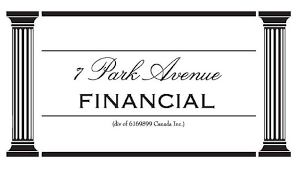|
The Ultimate Guide to Canadian Invoice Factoring
The Smart Business Owner's Guide to Invoice Financing
YOU WANT RECEIVABLES FINANCING AND WORKING CAPITAL FUNDING!
A NEW WAY TO MEASURE WORKING CAPITAL FINANCING NEEDS!
UPDATED 07/16/2025
You've arrived at the right address! Welcome to 7 Park Avenue Financial
Financing & Cash flow are the biggest issues facing business today
ARE YOU UNAWARE OR DISSATISFIED WITH YOUR CURRENT BUSINESS FINANCING OPTIONS?
CONTACT US
CALL NOW - DIRECT LINE - 416 319 5769 - Let's talk or arrange a meeting to discuss your needs
EMAIL -sprokop@7parkavenuefinancial.com

The R R Factor: A New Approach to Financing Receivables & Working Capital Funding in Canada
Understanding the Receivables to Revenue Ratio (R R Factor)
We call it the Receivables to Revenue Ratio or simply the RR factor. Unlike rest and relaxation, the RR factor will guide Canadian business owners in recognizing the right time to explore advanced methods of accounts receivable financing for working capital funding.
The receivable-to-revenue ratio is a financial metric that provides insight into a company's ability to turn its accounts receivable into cash. It measures how effectively a company manages its credit sales and collections and helps alert to negative working capital.
Here's how you can calculate it:
Receivables to Revenue Ratio = (Accounts Receivable / Sales Revenue) × 100
Interpretation: What the Receivables to Revenue Ratio Tells Business Owners
Accounts Receivable: This is the amount of money owed to the company by its customers for goods or services that have been delivered but not yet paid for.
Sales Revenue: The total amount of money the company earns from its products or services sales.
Stop Waiting for Payment – Get Your Cash Flow Today -How Does Accounts Receivable Financing Work
Your business is growing, orders are increasing, but your bank account tells a different story.
Outstanding invoices pile up while bills demand immediate attention.
Let the 7 Park Avenue Financial team show you how financing receivables transforms those unpaid invoices into immediate cash, eliminating the dangerous gap between delivery and payment that threatens your business stability.
3 Uncommon Takes on Financing Receivables
- Receivables financing acts as a customer credit department upgrade – When you factor receivables, you're essentially outsourcing credit risk assessment to experts who specialize in evaluating payment likelihood across industries.
- It's reverse insurance for your cash flow – Unlike traditional insurance that protects against losses, receivables financing prevents cash flow problems before they occur by converting future payments into present capital.
- Receivables financing creates a competitive advantage in bidding – Companies with immediate access to invoice value can offer better terms to customers and take on larger projects without worrying about cash flow timing.
Measuring Your Receivables Revenue Ratio
High Ratio: A higher ratio could indicate inefficiency in collecting and converting payments into cash. It may mean that a company is extending credit to customers who are not paying their bills promptly, which can impact cash flow and liquidity.
Low Ratio: A lower ratio could indicate that a company efficiently converts its credit sales into cash quickly. It may imply strong credit policies and collection practices, ensuring that the money owed is collected promptly.
In short, a receivable-to-revenue ratio is essential in assessing a company's liquidity and cash flow management. It offers insight into how well a company manages its credit policies and how quickly it's turning credit sales into cash. If mismanaged, it could lead to potential cash flow problems and increased risk, mainly if a significant portion of sales are made on credit.
The Importance of Calculating the RR Factor
Here's a powerful tool that's straightforward and potent in assessing cash flow challenges. It's called the receivables to revenue ratio, and by examining your year-end balance of A/R and translating it into weeks of sales, you'll have a historical perspective on your cash flow and working capital needs.
Tackling Working Capital Funding Challenges with Receivables Financing
But what does a company do when traditional borrowing for working capital seems daunting? Increasingly, Canadian firms are turning to factoring or accounts receivable financing. This method might seem complex, but it's quite simple once you comprehend the pricing and day-to-day functioning.
The Simple Solution: Invoice Factoring/Financing Accounts Receivables
Choose daily, weekly, or monthly intervals to sell your receivables on the company's balance sheet. When you make a sale, you receive immediate cash, transforming accounts receivable into an ATM for Canadian entrepreneurs and finance managers. Discovering this ultimate cash flow solution can be a game changer for small businesses and companies of all sizes.
The Two "Catches" of Financing Receivables
While accounts receivable financing might seem attractive, there are two "catches" that businesses need to understand and address.
Cost of Financing
The first is the cost compared to a traditional bank loan/unsecured financing, which typically ranges from 9% per month in Canada and in some cases, 1.15% per month, referred to as a discount fee.
Though this might seem expensive, many business owners do not consider the carrying cost of the receivables and the "opportunity cost"—the potential for higher profits using cash flow from receivable financing.
Why Isn't Every Canadian Business Using Receivable Financing?
The reality might surprise you; large Canadian firms often utilize this financing method for funding a company's sales revenue.
Their financial strength allows for more flexibility in managing this facility daily, often enabling them to bill and collect their receivables—something rarely found in the Canadian market.
There are different types of Receivable Finance. 7 Park Avenue Financial's recommended solution is non-notification Confidential Receivable Financing, allowing a business to bill and collect the company's accounts receivable while achieving all of the cash flow benefits of A/R financing.
Case Study
Manufacturing Company Success Story
A Toronto-based precision manufacturing company faced a critical cash flow crisis when their largest customer extended payment terms from 30 to 90 days.
With $500,000 in outstanding receivables and immediate supplier obligations, the company chose financing receivables through 7 Park Avenue Financial's network.
Within 48 hours, they received a cash advance of $450,000 (90% of invoice value), enabling them to,via the receivables finance process :
-
Pay suppliers and maintain production schedules
-
Accept a new $300,000 order without cash flow concerns
-
Invest in equipment upgrades that increased efficiency by 15%
Result: The company grew revenue by 40% over six months while maintaining healthy cash flow, eventually expanding to two additional locations.
Conclusion
Seek out the unique 1% solution that allows this flexibility. Your business can secure competitive working capital funding and virtually limitless cash flow growth.
Call 7 Park Avenue Financial, a trusted, credible, and experienced Canadian business financing advisor who will ensure you have the best and lowest cost capital funding solution tailored to your business, allowing you to unlock growth solutions and profits.
FAQ
What Is the Cash Conversion Cycle?
The Cash Conversion Cycle (CCC) is a critical metric that measures the time it takes for a company to convert its investments in inventory and other resources into cash flows from sales. It encompasses three stages: Days Sales Outstanding (DSO), which is the time taken to collect payment after a sale; Days Inventory Outstanding (DIO), which is the time taken to sell inventory; and Days Payable Outstanding (DPO), which is the time taken to pay suppliers.
The formula for calculating the company's cash conversion cycle "CCC" is:
CCC = DSO + DIO − DPO
Keywords related to CCC include working capital management, liquidity, operational efficiency, cash flow management, inventory turnover, and accounts payable/receivable.
What Is Debt Financing versus Equity Financing?
Debt Financing: This involves borrowing money, typically through loans, bonds, or other debt instruments, to be repaid with interest. It's a way for businesses to raise capital without giving up ownership. Keywords include interest, principal, creditors, leverage, and fixed obligations.
Equity Financing: This entails raising capital by selling shares or ownership in the company. Unlike debt financing, there's no obligation to repay the funds. Instead, shareholders may receive dividends and have a say in the company's operations. Keywords include shareholders, dividends, ownership, dilution, and capital structure.
What Is the Impact of Currency Exchange Rates in A/R Financing?
Currency exchange rates are vital in accounts receivable (A/R) financing, particularly for businesses dealing in multiple currencies. The fluctuation of exchange rates can affect the value of receivables, leading to currency risk; impact the cost and availability of A/R financing; and create complexities in managing international trade credit.
What Are Alternative Financing Options for Receivable Financing in Addition to Factoring?
In addition to factoring, alternative financing options for receivable financing include Invoice Discounting, which involves selling invoices to a third party at a discount but maintaining control over collections; Asset-Based Lending, which utilizes assets like receivables and inventory as collateral for a loan; Supply Chain Financing, which collaborates with suppliers and financial institutions to optimize working capital across the supply chain; and Peer-to-Peer (P2P) Lending, which leverages online lenders and their platforms to match borrowers with individual lenders.
What Is a Working Capital Loan?
A working capital loan is a specialized type of loan designed to finance the daily operational expenses of a business. Unlike traditional loans, often used to finance long-term investments or capital expenditures, working capital loans cover short-term needs like payroll, rent, inventory purchases, and other day-to-day expenses. This type of loan is particularly beneficial for businesses with cyclical or seasonal revenue patterns, where there might be gaps in cash flow.
There are various types of working capital loans, including Line of Credit, which offers flexible access to funds up to a specific limit, allowing businesses to draw and repay as needed; Term Loans, which provide a lump sum of capital paid back over a set term with interest; Invoice Financing, which advances funds based on unpaid invoices, enabling businesses to manage cash flow without waiting for customer payments; and Trade Credit, which involves obtaining goods from suppliers with a deferred payment agreement. The primary goal of working capital loans is to ensure liquidity and financial stability in the short term, allowing businesses to continue operating smoothly regardless of fluctuations in revenue or unexpected expenses.
What Is the Difference between a Working Capital Loan and Financing Receivables?
Both working capital loans and receivables financing are essential tools in managing a company's cash flow and liquidity, but they serve different purposes and function in distinct ways. Here's an outline of the key differences:
Working Capital Loan
Purpose: Aimed at funding the day-to-day operational expenses of a business, such as payroll, rent, utilities, and inventory. It's a tool to smooth out cash flow fluctuations.
Structure: This can be a term loan, line of credit, or other forms of short-term financing. The structure is often flexible, catering to the general working capital needs of the business.
Collateral: May or may not require collateral, depending on the lender's requirements and the borrower's creditworthiness. If needed, collateral can include various business assets.
Approval and Terms: The lender assesses the overall financial health of the business, including credit history, profitability, and financial stability. The terms can vary widely based on these factors.
Financing Receivables (e.g., Accounts Receivable Factoring or Invoice Discounting)
Purpose: Leveraging unpaid invoices or accounts receivable (A/R) to generate immediate cash. It helps bridge the gap between invoicing a customer and receiving payment and avoids the need to borrow money via term debt.
Structure: Selling or using the A/R as collateral to get an advance from a financial institution or factoring company. The advance is typically a percentage of the invoice's face value.
Collateral: The collateral is the receivables themselves. The lender's security is tied to the quality and collectibility of the financed invoices.
Approval and Terms: The lender's focus is often on the creditworthiness of the invoiced customers rather than the company seeking financing. The terms are closely tied to the receivables' value, age, and risk.
While working capital loans provide a more general form of financial support for daily operations, financing receivables is a specialized method tied to leveraging unpaid invoices to improve cash flow. The former takes a broader view of the business's financial health, while the latter is closely related to specific transactions and the creditworthiness of the company's customers.
What makes financing receivables different from traditional lending?
Financing receivables focuses on your customers' creditworthiness rather than your business credit score, making it accessible to newer businesses or those with credit challenges who have quality customers.
How does the financing receivables process work step-by-step?
Financing receivables begins with application and approval, followed by invoice submission, immediate funding of 80-90% of invoice value, customer payment to the factor, and final payment of the remaining balance minus fees.
What should businesses consider before choosing financing receivables?
Financing receivables requires evaluating costs versus benefits, understanding customer notification preferences, assessing long-term cash flow needs, and ensuring customer creditworthiness meets factor requirements.
Is financing receivables the same as factoring?
Financing receivables and factoring are essentially the same process – selling your accounts receivable to a third party for immediate cash rather than waiting for customer payments.
Can I use financing receivables for just some of my invoices?
Financing receivables can be structured for selective invoices or entire receivables portfolios, allowing businesses to choose which invoices to factor based on cash flow needs.
What industries commonly use financing receivables?
Financing receivables is popular across manufacturing, distribution, staffing, transportation, and professional services industries where B2B invoicing with extended payment terms is standard practice.
How does financing receivables differ from invoice discounting?
Financing receivables involves selling invoices to a third party who handles collections, while invoice discounting provides loans secured by receivables with the business maintaining customer relationships.
Will financing receivables affect my ability to get other financing?
Financing receivables may actually improve access to other financing by strengthening cash flow and demonstrating consistent revenue, though some lenders may require notification of factoring arrangements.
Citations
- Canadian Federation of Independent Business. "Cash Flow Challenges in Small Business." CFIB Research Report, 2024. https://www.cfib.ca
- Bank of Canada. "Alternative Business Lending in Canada." Financial System Review, 2024. https://www.bankofcanada.ca
- Industry Canada. "Small Business Financing Statistics." Innovation, Science and Economic Development Canada, 2024. https://www.ic.gc.ca
- Factoring Association of Canada. "Annual Industry Report." Canadian Factoring Statistics, 2024. https://www.factoringcanada.ca
- Statistics Canada. "Small Business Quarterly Financial Survey." Government of Canada, 2024. https://www.statcan.gc.ca
- 7 Park Avenue Financial." Finance Factoring Receivable Financing Canada".https://www.7parkavenuefinancial.com/finance-factoring-receivable-financing-canada.html

' Canadian Business Financing With The Intelligent Use Of Experience '
STAN PROKOP
7 Park Avenue Financial/Copyright/2025

ABOUT THE AUTHOR: Stan Prokop is the founder of 7 Park Avenue Financial and a recognized expert on Canadian Business Financing. Since 2004 Stan has helped hundreds of small, medium and large organizations achieve the financing they need to survive and grow. He has decades of credit and lending experience working for firms such as Hewlett Packard / Cable & Wireless / Ashland Oil
Show Mobile Site
|